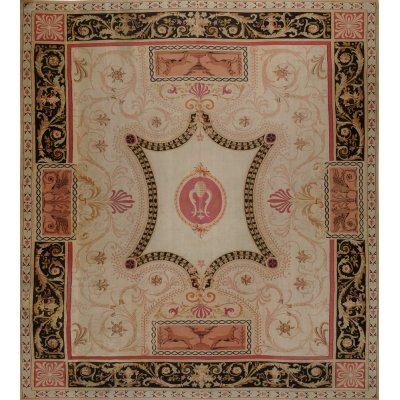Rug Guides: Antique Rugs
Designers, decorators and collectors travel the world far and wide to find authentic antique rugs. Antique rugs are recognizable first and foremost for their unique patina. Antique rugs were typically colored with vegetable dye, using as many as 20 different hues on a single rug. Over time, the rug will fade in certain areas, known as abrash coloration, which creates the visual highs and lows that distinguish an antique rug from a new rug.

What is the Difference Between an Antique, Semi-Antique, and Vintage Rug?
Antique & Semi-Antique Rugs
Historians agree that anything over 100 years old can be classified as a classic antique. Antique rugs, however, can be anywhere from 75 years to 100 years old. A semi-antique rug is one that’s roughly 50- to 74 years old.
Vintage Rugs
The term “vintage” is a relatively recent categorization used for something that’s neither new nor antique. It would be safe to say a rug that’s around 25 years old, for example, could be considered a vintage rug.
Where Antique Rugs are From
There are many different types of antique rugs, including Caucasian, Moroccan, Anatolian, and Aubusson. The majority of antique rugs on the market today are antique Persian rugs from the middle east, including Afghanistan, Iran, and Turkey. That area, was the epicenter of rug weaving before the industry moved to India, Pakistan, and Romania. However, there are rare handmade rugs that date as far back as the 15th and 16th centuries featuring French motifs and made in Europe.
How Do I Know if My Rug is an Antique?
Determining the age and era of a rug is very challenging and takes a great deal of skill. That being said, there are some keys thing to check.
- Wear - Antique rugs will often show signs of wear, such as the pile being worn down or exposed.
- The underside - Unlike a new rug which will be fuzzy on the bottom, an older distressed rug will have the fuzz on the back worn down so it is grainy or smooth.
- Flexibility - a new rug will still be stiff, but an older rug becomes more pliable and supple.
- Dye color - as rugs age some colors will become paler due to light exposure. You can fold the rug to look at the root of the fibers to see if they’re the same color.
Imperfections - new rugs are made with machinery and lack the variation in colors that naturally occurs with hand-knotted rug weaving techniques. Also, an old rug is more likely to have had repairs made over the years - check the back, where it’s easiest to tell if work has been done.
Sourcing Antique Rugs
Matt Camron Rugs finds its antique rugs around the world through relationships with discerning dealers who pass the antique carpets through a series of observations to determine quality and place of origin. Through keep visual examination, antique dealers can deduce whether or not the rug has been through a restoration.
If the perfect antique rug for your home or project simply can’t be found, Matt Camron’s expert designers and master weavers are able to custom create an antique reproduction. Some of the most popular and frequently requested styles of antique rugs include antique Persian rugs and antique Oriental rugs. The Matt Camron team will hand dye the wool to achieve color variation, carefully shear the wool, and graph the motif by hand. Matt Camron also provides care for your rugs after your purchase with rug cleaning and rug repair services.
View Matt Camron’s collection of antique rugs or contact us to talk about your very own antique rug reproduction. You can also continue your own rug education by reading more about antique Persian rugs or antique Oriental rugs.
Included Styles
French Aubusson Rugs
Aubusson Style
Many of the first Aubusson-style rugs were modifications of Oriental designs, such as Ushak. Soon though, antique French Aubusson rugs were heavily influenced by the renaissance and followed the stylistic evolution of Savonnerie carpets, but had simpler designs with subdued colors and the use of lush garden plants and garlands.
Aubusson French carpets typically have a higher pile than Persian rugs, which allows for the creation of deeper carves and different design motifs.
Often including a floral design, Aubusson tapestries and rugs utilize a variety of rich coloring, including pastel dyes, to create art that was and still is a central point of one’s home decor.
Lasting Influence
The style of Aubusson carpets had an enormous influence on overseas production, and between the end of the 18th century and the mid-19th century, it became the model to imitate, even in the Orient and especially in Anatolia.
(Other spelling: Aubuson)
What is an Aubusson rug?
Like many other rugs, Aubusson rugs take their name from the French town Aubusson, lying on the banks of the Creuse River. Aubusson established its reputation in the 18th century, becoming an early weaving center for rugs and tapestries. Most Aubusson carpets were flat-woven using the tapestry technique, which was quicker, easier, and cheaper to produce.
They followed the stylistic evolution of Savonnerie carpets but had simpler designs with subdued colors and the use of lush garden plants.

Aubusson
- 17832HM
- 12' 0'' x 12' 3''

Antique European Aubusson Rug
- 17640HMS
- 16' 0'' x 18' 0''

Antique European Antique Aubusson Rug
- 16345HM
- 15' 5'' x 17' 2''
You cart is empty. Shop now


